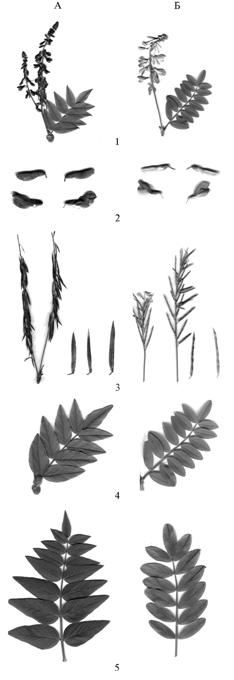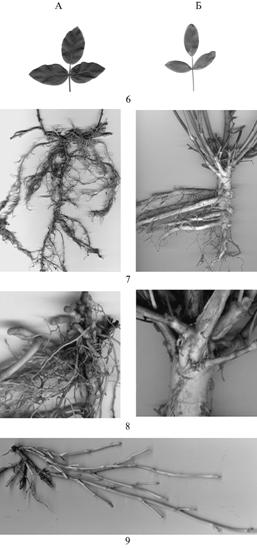УДК 633.26/.29:581.6:581.9
FEATURES OF GROWTH AND DEVELOPMENT OF Galega orientalis Lam. AND G. officinalis Lam. IN THE CONDITIONS OF EASTERN SIBERIA
R.A. Sagirova
The author for the first time made the comparative investigation of the growth and the development of Galega orientalis Lam. and G. officinalis Lam. (on botany-morphological characteristics) in connection with introduction. It was established, that G. officinalis do not reveal winter resistance in extreme climatic conditions of Eastern Siberia.
Key words: Galega orientalis Lam., Galega officinalis Lam., growth, development.
In the taxonomy of Leguminosae (Fabaceae), there are 8 species of the genus Galega distributed in Mediterranean countries, in Caucasus and Asia region (Asia Minor). Two of these species (Galega orientali Lam. , Galega officinalis Lam.) grow in the territory of Russia and the former USSR countries. Recently, in Russua and abroad, G.orientalis Lam. is introduced as a highly-productive promising fodder plant, as well as G. officinalis Lam., though the high content of toxic alkaloids in it. The literature data suggest the expedient possibility of using this plant in forage production (1, 2). However, unlike G.orientalis, G. officinalis keeps the high content of alkaloids poisonous for cattle (saponin, galegin), which obliges the need to mix it with cereal crops. Goats and sheep are the most sensitive to these toxic substances (lethal dose - 3 kg of grass) (3).
The purpose of our study was the comparative evaluation of growth and development of Galega orientalis Lam. and Galega officinalis Lam. in connection with introduction of these plants.
Methods. The research was carried out in the educational farm "Molodezhnyj" of the Irkutsk State Agricultural Academy in 1997-2000. Two sequentially experiments were embedded in 3-fold repetition each one. In the second half of May 1997, the seeds were sowed in the plots of 12-15 m2 in rows with 15 cm interspaces to the depth of 2-3 cm, at non-covering way of germination. The weight of 1000 seeds of G.orientalis and G.officinalis was 7.4 and 7.0 g, respectively. On the 4-th year of growing, G.officinalis was completely winter-killed.
In Cisbaikalia, the climate is sharply continental, with significant seasonal and diurnal temperature fluctuations, lack of moisture and heat, and a short vegetation period (94 days). Average annual precipitation is 330-370 mm, and during the vegetation period - 280-340 mm. The sum of active temperatures - 1400-1700 °C. Weather conditions during the experiment were generally typical for Cisbaikalia and promoted growth and development of plants. The soil of the test plots - gray forest, granulometric composition - medium loamy, the depth of arable layer 20-22 cm, 4.7 pH of soil extract, 2,4% of humus, high content of phosphorus and low - of potassium and nitrogen.
Preliminary evaluation was performed according the methodological instructions (4). Morphological features of the plants were described using the terminology proposed by A.A. Fedorov et al. (5-7) for the leaves, stems, roots and inflorescences of higher plants.
Results. In experimental conditions, G.officinalis exhibited low winter resistance (preservation of plants - 17%),
 |
|
Morphological characteristics of plant organs of Galega orientalis Lam.(А) and GalegaofficinalisLam. (Б): 1 — top of a steam , 2 — flowers and flower buds, 3 — fruiting inflorescences and legumes, 4 — leaves of the upper tier, 5 — leaves of the middle tier, 6 — leaves of the lowest tier, 7 — underground system, 8 — renewal zone, 9 — rhizome of G.orientalis. |
mowing ripeness (the phase of budding and early flowering) on the 70-74-th day from sprouting and the extended flowering period (up to 42-47 days). Yields of green and dry phytomass (average for 2-3rd years of growing) were 7,2 and 1,5 t / ha, respectively, which was at average in 3,7 times less than ones of G.orientalis. The phase of milk ripeness was achieved in the end of growing season, which did not ensure the production of seeds. Life expectancy of G.officinalis was 3 years (Table 1). Consequently, in the first experiment on introduction of G.officinalis (1996-1999), the authors established its unfit for cultivation in Cisbaikalia.
1. Characteristics of productivity, growth and development of Galega orientalis Lam. and Galega officinalis Lam. at their introduction in the forest-steppe zone of Cisbaikalia (Irkutsk reg., 1997-2000). |
|||||||
Species |
Winter resis- |
Start of sprou- |
Duration from sprouting, days |
Number of stems, thousand pieces/ha |
Biological productivity, t/ha |
||
to budding and flowering |
to seeds ripening |
green phytomass |
dry phytomass |
||||
Galega orientalis Lam. |
96 |
May 10 |
39 |
82 |
3389,4 |
30,4 |
7,5 |
Galega officinalis Lam. |
17 |
May 16 |
72 |
Seeds of the milk ripeness |
914,4 |
7,2 |
1,5 |
NSR05 on the dry phytomass is 3,2 t/ha |
|||||||
The authors described the morphobiological characteristics of single overwintered plants of G.officinalis and found the significant differences from G.orientalis (Table 2, Fig.).
The above-ground system of G.orientalis and G.officinalis (in average for 2-3rd years of life) consisted of stems (respectively 6 ± 2 and 10 ± 3 units / plant). Leaves - compound (odd pinnated), alternate, petiolate, with a terminal leaflet, differ in color and shape of leaflets (see fig.).
2. Botany-morphological characteristics of Galega species growing in the forest-steppe zone of Cisbaikalia (1997-1999) |
||
Characteristic |
Galega orientalis Lam. |
Galega officinalis Lam. |
Life-form |
Herbaceous perennial plant of Leguminosae family , grows in one place for 15-20 years ; robust erect stems 78,1-96,5 cm high |
Herbaceous perennial plant of Leguminosae family , grows in one place for 3 years; robust erect stems 65,0-77,6 cm high |
Leaves |
Compound (odd pinnated), by 17,5±4,3 cm long |
Compound (odd pinnated), by 13,2±3,6 cm lengh |
Leaflets |
4 - 7 pairs, ovate or oblong-ovate, 1,4-3,7 cm long, 1,3-3,4 cm wide, dark-green top |
7 - 10 pairs, lanceolate or oblong-lanceolate, 1,3-3,5 cm long, 0,5-1,5 cm wide, light-green top |
Inflorescence |
Racemose 9-17 cm long |
Racemose 4-11 cm long |
Flowers |
Blue-violet |
Blue-violet, lilac, white |
Legume |
Drooping, rarely horizontal, 2,2-4,5 cm long |
Obliquely erected, with valves between seeds, 1,5-2,5 cm long |
Underground system |
Tap-rooted, the main root without a bulb, penetrates into soil to the depth of 2,2 m, with renewal buds (up to 6) in basal part of a stem and rhizomes (up to 11 pcs.) |
Tap-rooted, the main root with a bulb, penetrates into soil to the depth of 0,6 m, with renewal buds (up to 14) in basal part of a stem, without rhizomes |
Winter resistance |
High |
Low |
The underground system of the studied Galega species is tap-rooted, consists of roots of various morphology, penetrating to different depths, in G.officinalis - without rhizomes (in contrast to G.orientalis) (see fig.). At the same time, the seeds of both species are very similar in form, color, and in weight of 1000 seeds, which should be borne in mind when purchasing.
So, the first time was found that Galega officinalis Lam. is not suitable for cultivation in Cisbaikalia owing to its late ripening, low winter resistance (17% in average for the years of experiment), low mowing ripeness (the phase of budding and early flowering), which is to be achieved on the 70-74 th day from the beginning of sprouting, extended flowering period (up to 42-47 days). The yield of green and dry phytomass of Galega officinalis Lam. is inferior to Galega orientalis Lam. in average by 3,7 times. By the end of growing season in Cisbaikalia, the seeds of Galega officinalis Lam. achieve the phase of milk ripeness only, which doesn’t ensure seed production.
REFERENCES
1. Sagirova R.A., Ontogenetic Morphogenesis of Galega orientalis Lam. as the Promising Forage Plant, S.-kh. biol., 2009, no. 4, pp. 75-80.
2. Outeush Yu.A., Novyje perspektivnyje kormovyje kultury (New Promising Forage Crops), Kiev, 1991.
3. Gusynin I.A., Toksicologiya yadovitykh rastenij (Toxicology of Poisonous Plants), Moscow, 1955, pp. 262-263.
4. Isucheniye kollektsii mnogoletnykh kormovykh rastenij. Metodicheskiye ukaszniya (Study of the Collection of Perennial Fourage Plants. Methodological Guidelines)/ Composed by A.I. Ivanov, A.V. Bukhteyeva, Z.P. Shutova e.a., Leningrad, 1985, p. 47.
5. Fedorov A.A., Kirpichnikov M.E. and Artushenko Z.T., Atlas po opisatelnoj morfologii vyschih rastenij. Sotsvetiye (Atlas of Descriptive Morphology of Higher Plants. Inflorescence), Moscow - Leningrad, 1979.
6. Fedorov A.A., Kirpichnikov M.E. and Artushenko Z.T., Atlas po opisatelnoj morfologii vyschih rastenij. List (Atlas of Descriptive Morphology of Higher Plants. Leaf), Moscow - Leningrad, 1956.
7. Fedorov A.A., Kirpichnikov M.E. and Artushenko Z.T., Atlas po opisatelnoj morfologii vyschih rastenij. Stebel’ i coren’ (Atlas of Descriptive Morphology of Higher Plants. Steam and Root), Moscow - Leningrad, 1962.
State Agrarian University, Moscow Agricultural Academy of K.A. Tymiryazev, |
Received April 4, 2007
|














